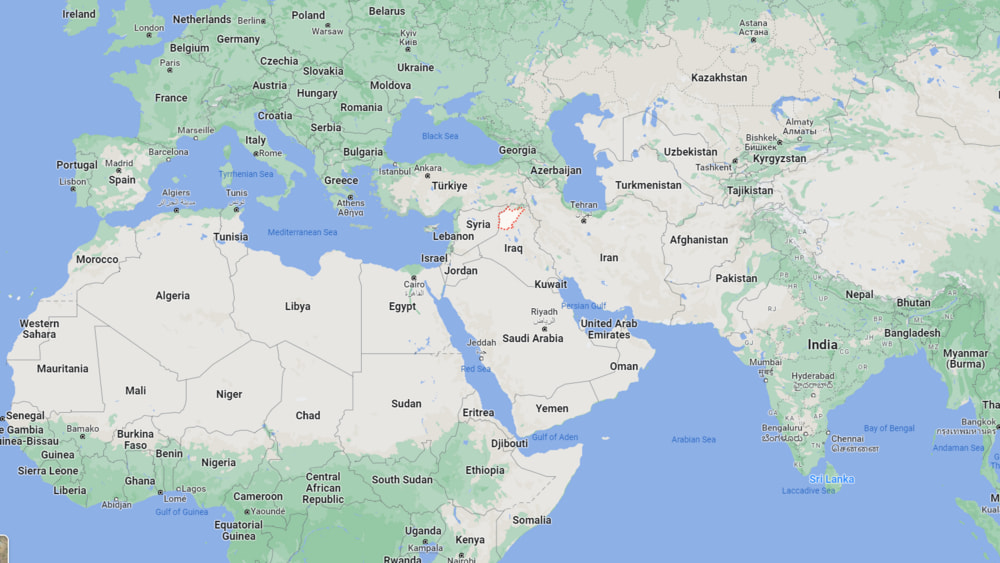Nineveh was an ancient city located in what is now modern-day Iraq. It was situated on the eastern bank of the Tigris River, near the present-day city of Mosul. The ruins of Nineveh can be found in the Nineveh Governorate of Iraq, approximately 20 kilometers (12 miles) northeast of Mosul. Nineveh was the capital of the Neo-Assyrian Empire and was a significant center of political, cultural, and military power during its time. The ancient city of Nineveh holds great historical and archaeological importance and is recognized as a UNESCO World Heritage site.
Location Map of Ninevah, Iraq
 About Map: Map showing Where is Ninevah, Iraq located in the Map.
About Map: Map showing Where is Ninevah, Iraq located in the Map.
About Ninevah
Nineveh, also spelled Ninevah, refers to an ancient city that was a prominent cultural, political, and military center in Mesopotamia. Here is some information about Nineveh.Location: Nineveh was located in what is now modern-day Iraq. It was situated on the eastern bank of the Tigris River, in the present-day Nineveh Governorate. The ruins of the ancient city are near the city of Mosul.
Historical Significance: Nineveh was the capital of the Assyrian Empire, one of the most powerful and influential empires in the ancient world. It reached its peak during the reign of King Sennacherib (704-681 BCE) and became a major political and cultural center of the ancient Near East. Assyrian Empire: The Assyrian Empire was known for its military might and expansionist policies. Nineveh played a crucial role in the empire's administration, trade, and military operations. The city was adorned with impressive palaces, temples, and fortifications.
Fall and Rediscovery: Nineveh faced several conquests and destructions over its history. The city was eventually sacked and destroyed in 612 BCE by a coalition of Babylonians, Medes, and others. After its fall, Nineveh was largely abandoned and gradually fell into ruins. Its ruins were rediscovered and excavated by archaeologists in the 19th and 20th centuries. Archaeological Discoveries: Excavations at the site of Nineveh have revealed remarkable archaeological treasures, including the remains of palaces, temples, walls, and sculptures. The most famous discovery is the palace of King Sennacherib, which contained magnificent reliefs depicting scenes of royal life and military campaigns.
Cultural Legacy: Nineveh holds great historical and cultural significance. The city is mentioned in the Bible, particularly in the book of Jonah, where the prophet Jonah is said to have preached against the city's wickedness. The Assyrian Empire's influence and cultural legacy can be seen in various aspects of ancient Near Eastern history, art, and literature. Today, the ruins of Nineveh stand as a testament to the grandeur and power of the ancient Assyrian civilization. The archaeological findings from Nineveh have provided valuable insights into ancient Mesopotamian culture and history.
World Travel Destinations
- 100 Wonders Of The World
- 7 Wonders Of World
- Where is Acropolis
- Where is Alhambra
- Where is Amalfi Coast
- Where is Amazon Rainforest
- Where is Angel Falls
- Where is Angkor Wat
- Where is Bali
- Where is Banaue Terraces
- Where is Bora Bora
- Where is Borobudur
- Where is Burj Khalifa
- Where is Cappadocia
- Where is Carlsbad Caverns
- Where is Chichen Itza
- Where is Colosseum Of Rome
- Where is Dubrovnik
- Where is Easter Island
- Where is Eiffel Tower
- Where is Fjords Of Norway
- Where is Galapagos Islands
- Where is Grand Canyon
- Where is Great Barrier Reef
- Where is Great Pyramid Of Giza
- Where is Great Wall Of China
- Where is Iguazu Falls
- Where is Konark Temple
- Where is Leaning Tower Pisa
- Where is Louvre Museum
- Where is Machu Picchu
- Where is Marrakesh
- Where is Matterhorn
- Where is Mecca
- Where is Mount Everest
- Where is Pagan Temples
- Where is Petra
- Where is Pompeii
- Where is Portofino
- Where is Potala Palace
- Where is Sahara Desert
- Where is Santorini
- Where is Sistine Chapel
- Where is Stonehenge
- Where is Suez Canel
- Where is Taj Mahal
- Where is Teotihuacan
- Where is Terracotta Warriors
- Where is Valley Of The Kings
- Where is Versailles
- Where is Victoria Falls
- Where is Mount Rushmore
- Where is Prague
- Where is Tunis
- Where is Curacao
- Where is Babylon
- Where is Death Valley
- Where is Tahiti
- Where is Oak Island
- Where is Mount Fuji
- Where is Timbuktu
- Where is Canary Islands
- Where is Monte Carlo
- Where is Atlantis
- Where is Dead Sea
- Where is Amalfi Coast
- Where is Kosovo
- Where is Great Barrier Reef
- Where is Panama Canal
- Where is The Red Sea
- Where is Aconcagua Mountain
- Where is Azores
- Where is Devil'S Tower
- Where is Antwerp
- Where is The Faroe Islands
- Where is Santorini
- Where is Kilimanjaro
- Where is Banff National Park
- Where is Mount Olympus
- Where is Ninevah
- Where is Mount Etna
- Where is Deadwood
- Where is Lake Titicaca
- Where is Yucatan Peninsula
- Where is Mount Mckinley
- Where is Angel Falls
- Where is The Blue Lagoon
- Where is Petrified Forest
- Where is Rock Of Gibraltar
- Where is Glass Beach
- Where is Atacama Desert
- Where is Mount Ararat
- Where is Falkland Islands
- Where is Channel Islands
- Where is Badlands National Park
- Where is Tree Of Life
- Where is Dubrovnik
- Where is Loch Ness
